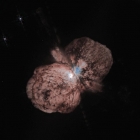Theodore Gull, Goddard Space Flight Center
Eta Carinae: a Demanding Mistress
In the 1840's a
southern star, Eta Argus, brightened to rival Sirius for nearly a decade, then faded. Today, we see the Homunculus, an hourglass figure with tutu, a dusty shell exceeding 12 solar masses expanding outward at 500
km/s. Many observers have systematically studied the massive binary total shrouded
by interacting winds and its ejecta. More recently 3-D wind-wind collision
models have begun to explain the extended structures resolved by Hubble Space Telescope. Now Herschel Space Observatory infrared scans are revealing wind interaction emissions and complex molecules left over from the dust
that
formed out of gas originally overabundant in nitrogen and greatly-depleted in oxygen and carbon.
Many questions remain to be answered:
What is the dust that formed in the
1840s event?
What are the end states of the two
massive companions... SN, GRB, Hypernova?
and When?
Host: George Gull

